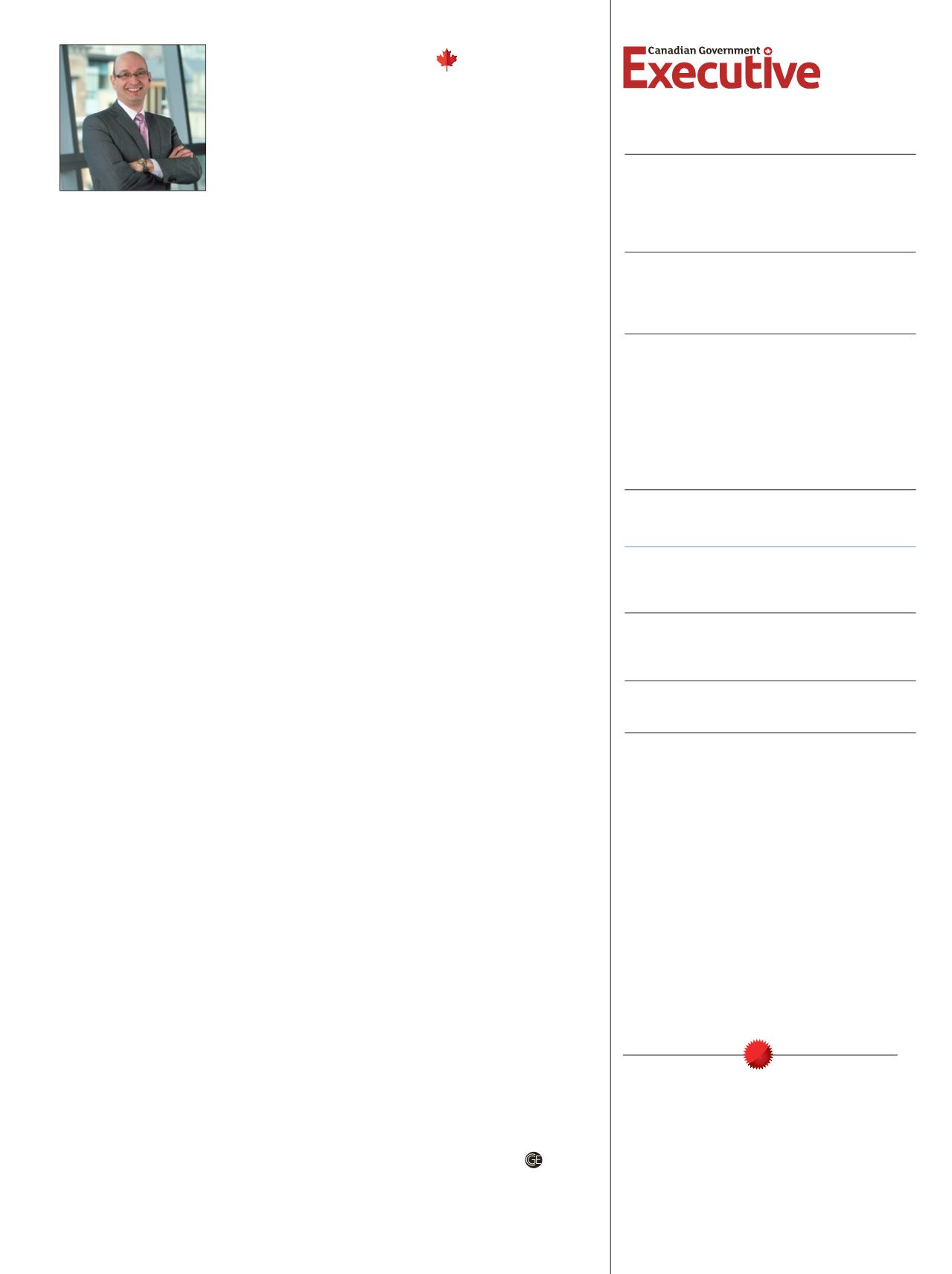

Our mission is to contribute to excellence in public service management
Editorial
Editor-in-Chief:
Patrice Dutil
editor@netgov.ca www.particedutil.comAssociate Editor:
Jason McNaught
assoceditor@netgov.caEditorial Advisory Board
Vic Pakalnis, Mirarco, Laurentian University; Denise Amyot,
CEO, ACCC; Nick Frate, Federal Youth Network; George Chin,
Provincial Interministerial Council, OPS; Jodi LeBlanc,
Veterans Affairs
sales
VP Business Media Strategy:
Marcello Sukhdeo
905-727-3875 x224
marcellos@netgov.caVice President, Sales:
Terri Pavelic
905-727-4091 x225
terrip@netgov.caDirector, Content & Business Development:
José Labao
905-727-4091, x231
josel@netgov.caart & production
Art Director:
Elena Pankova
artwork@netgov.caSubscriptions and Address Changes
Circulation Director:
Mary Labao
289-879-4272
circulation@netgov.caGeneral Inquiries
23-4 Vata Court, Aurora, ON, L4G 4B6
Phone 905-727 4091 Fax 905-727-4428
www.canadiangovernmentexecutive.cacorporate
Group Publisher:
John Jones
publisher@netgov.caPublisher’s Mail Agreement:
41132537 ISSN 1203-7893
Canadian Government Executive
magazine is published 10 times per
year by Navatar Press. All opinions expressed herein are those of the
contributors and do not necessarily reflect the views of the publisher
or any person or organization associated with the magazine. Letters,
submissions, comments and suggested topics are welcome, and should
be sent to
editor@netgov.caReprint Information:
Reproduction or photocopying is prohibited without the publisher’s prior
written consent. High quality reprints of articles and additional copies of
the magazine are available through
circulation@netgov.caPrivacy Policy:
We do not sell our mailing list or share any
confidential information on our subscribers.
We acknowledge the financial support of the Government of Canada
through the Canada Periodical Fund (CPF) for our publishing activities.
www.canadiangovernmentexecutive.ca4
/ Canadian Government Executive
// November 2015
I write this on the day following the general election that resoundingly put the Liberal
Party back in power; the first Liberal majority victory in fifteen years. Is there hope for
a new approach to managing the modernization of the state apparatus? Will the new
government allow for more experiments in public policy and finally harness the power
of the Internet?
The Conservative Party left with many clouds over its head, many of which originated
from the way it managed its relations with the bureaucracy in public. Its attitude cre-
ated differences over the place of science in policymaking and as a government activity.
It probably lost a few votes over the issue of the long-form census alone (really, where
else but in Canada could this sort of issue come to a head?). There were concerns about
partisanship in dealing with the bureaucracy but mostly there was a discomfort that the
public service was not allowed to play the policy role it considers its sacred domain.
In fairness, every government has had to deal with these issues and I’m still not con-
vinced that the Conservatives did much worse than their predecessors (remember how
the Liberal government under Jean Chrétien gutted science in Environment Canada,
Fisheries and Oceans, and Natural Resources?). Otherwise, the Conservative reign was
remarkably quiet in terms of its labour relations with government employees (in con-
trast, remember the 1970s, 80s and 90s?).
The new government has a tremendous opportunity to lead Canadian governance in a
great leap forward. True to form, it has announced a bold new approach to a “fair and open
government” (fans of
Yes, Minister
! will imagine Sir Humphrey Appleby turn agonizingly in
his literary grave). The Liberal Party platformdeclared it would continue to improve access
to government data. It is significant that the Liberals announced that it is “especially impor-
tant to us that government work well, and be seen to work well.” They have also promised
“better public services and more effective public servants.” On the premise that “Ottawa is
broken” the Liberals say they have a “comprehensive plan to fix it.”
I think I’ve heard these lines before, but let’s lean on the side of optimism. The Liberal
platform is filled with commitments for better service to Canadians, including individ-
ualized, secure accounts for citizens who want better, faster access to government ser-
vices. It promises higher performance standards for services, a reduction in red tape,
reductions of wait times and money-back guarantees. There is a commitment to inde-
pendent assessments of performance and better public reporting of results. There is a
promise of expansion of online services, but at the same time there is a commitment
to expand in-person service where “it is critical in the delivery of programs.” There is a
commitment to consult Canadians on decisions and “evaluations of existing programs
and policies,” and this will start with door-to-door home mail delivery. The Liberal plat-
form promises to continue the practice; it will be fun to see where it will end.
All this wrapped-up in a promise to deliver evidence-based decision-making.
This month’s issue shows where governments have embraced new methods and
new strategies to make service leaner, faster and better targeted. There is much to
be learned from the examples of the Region of Peel and the District of Mission. Roger
Oldham reminds us that nothing is possible without leadership, however.
We live in a time when technological and governance innovations seem so promis-
ing. There is an appetite to improve every dimension of our governance. I hope the new
government lives up to its high promises and genuinely creates an environment where
public servants can indeed strive to meet their equally high commitments.
A New Opportunity (?)
editor’s note
Patrice Dutil
web
LEADERSHIP
SUMMIT 2015
THE DEST INAT ION 2020 LEADERSHI P JOURNEY














